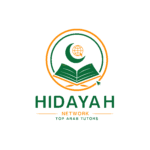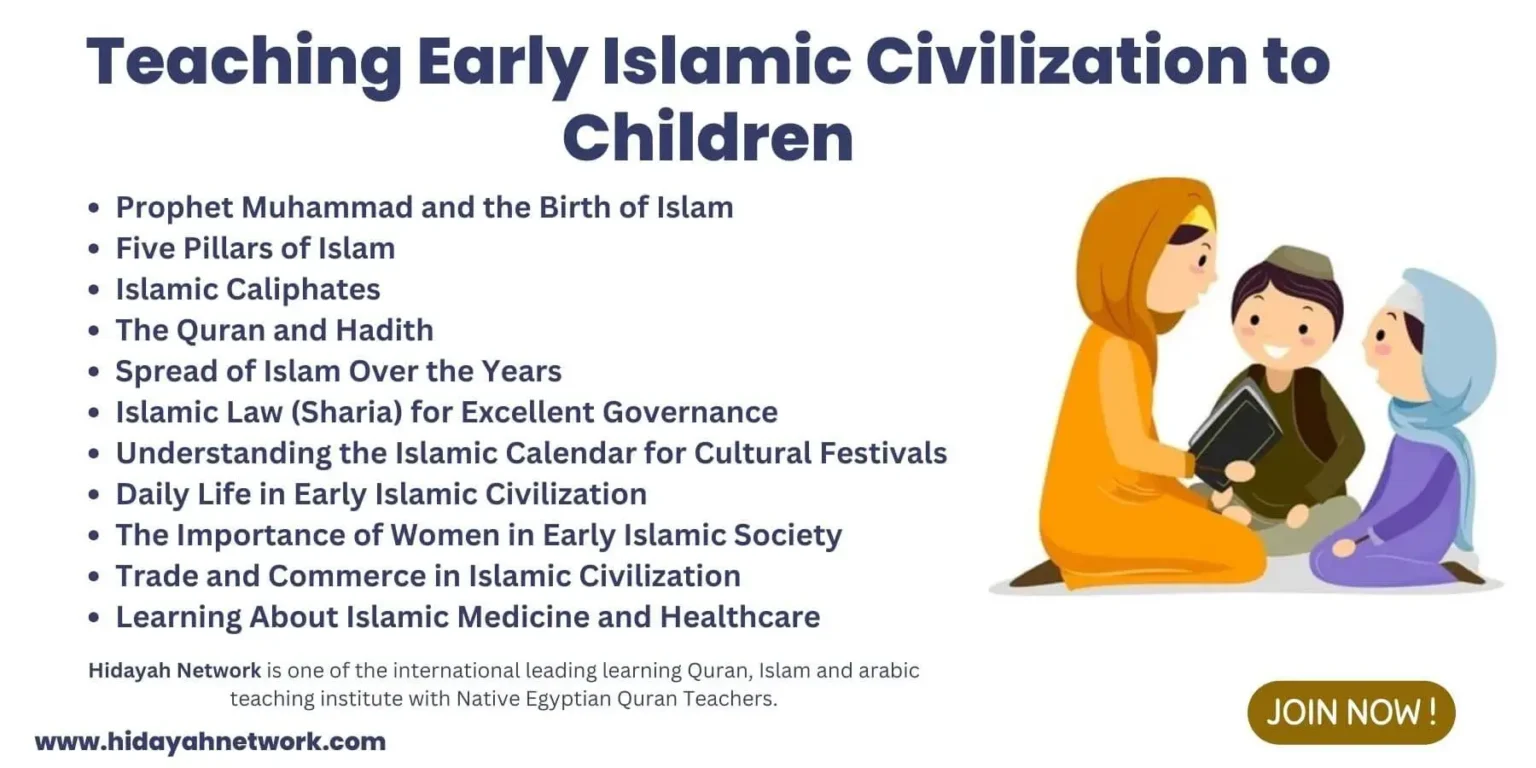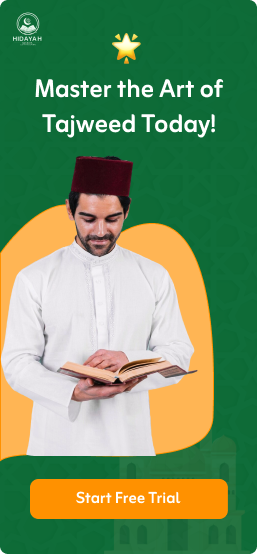Teaching Early Islamic Civilization to Children

- Hidayah
- Network
- | Role: Hidayah Network

Introducing children to the rich history of Early Islamic Civilization is an exciting journey through time, culture, and discovery. But don’t know where to begin? Today, we will help you provide all the tips you need to help teach your kid where history, faith, and innovation intertwine to shape the foundation of a dynamic society according to Islam.
You can begin by explaining the life of Prophet Muhammad and the birth of Islam, five pillars of Islam, Articles of faith, Islamic Caliphates, the Quran and Hadith, Islam’s spread over the years, Islamic Shariah, important days in the Islamic calendar, Islamic studies for kids and so on.
Teach Islamic Civilization to Children for Cultural Development
1. Prophet Muhammad and the Birth of Islam
Teaching children about Prophet Muhammad and the Birth of Islam is crucial for understanding Islamic civilization. Prophet Muhammad was the messenger of Allah and the founder of Islam. He was born in Mecca and received revelations from Allah through the Angel Jibrael. These revelations were compiled into the Quran, the holy book of Islam.
The first ayah, or verse, of the Quran was revealed to Prophet Muhammad in the cave of Hira. It was a profound moment when Allah spoke directly to him through Angel Jibrael, initiating his mission as a prophet. This event marks the beginning of Islam and is significant because it established the divine connection between Allah and humanity through Prophet Muhammad.
Teaching children about this momentous occasion helps them appreciate the spiritual significance of Islam and its impact on history and culture.
Get 40% OFF Now!
2. Five Pillars of Islam
The Five Pillars of Islam are the fundamental acts of worship that Muslims follow. Teaching children about the Five Pillars helps them understand the core principles and practices of Islam. It instills values of faith, prayer, charity, self-discipline, and unity within the Muslim community.
They include:
| Pillar | Description |
| Shahada | Declaring belief in the oneness of Allah and that Muhammad is his messenger. |
| Salah | Performing five daily prayers facing towards the Kaaba in Mecca. |
| Zakat | Giving charity to those in need, typically a percentage of one’s wealth. |
| Sawm | Fasting from dawn to sunset during the month of Ramadan. |
| Hajj | Making a pilgrimage to the holy city of Mecca at least once in a lifetime, if able. |
3. Islamic Caliphates
Islamic Caliphates were historical periods in Islamic history when the Muslim world was ruled by a caliph, who was considered the successor to Prophet Muhammad. Teaching children about Islamic Caliphates helps them understand the historical context of Islamic civilization and appreciate its diverse and rich heritage.
| Caliph | Begin | End | Rule |
| Rashidun Caliphate | 632 CE | 661 CE | The Rashidun Caliphs were the first four caliphs after Prophet Muhammad’s death. They led the Muslim community with wisdom and justice. |
| Umayyad Caliphate | 661 CE | 750 CE | The Umayyad Caliphate expanded Islamic territories and established Damascus as its capital. They were known for their administrative and architectural achievements. |
| Abbasid Caliphate | 750 CE | 1258 CE | The Abbasid Caliphate was a golden age of Islamic civilization, with Baghdad as its capital. They made significant contributions to science, art, and philosophy. |
| Ottoman Caliphate | 1517 CE | 1924 CE | The Ottoman Caliphate was the last caliphate, ruling over a vast empire that spanned three continents. They were known for their military prowess and cultural achievements. |
4. The Quran and Hadith
The Quran is the holy book of Islam, believed by Muslims to be the word of God as revealed to Prophet Muhammad. It contains guidance on how to live a righteous life, covering topics like faith, morality, and laws.
Hadiths are sayings, actions, or approvals of Prophet Muhammad recorded by his companions. They provide additional guidance and explanations for practicing Islam.
Teaching children about the Quran and Hadiths helps them understand the foundation of Islamic beliefs and practices. It instills values of respect for religious texts, encourages moral behavior, and deepens their connection to their faith and community. It helps them to learn Islam from the beginning so that they start practicing Islam in their early ages.
5. Spread of Islam Over the Years
The spread of Islam over the years refers to how the religion expanded from its origins in Arabia to become one of the world’s major religions. It’s important to teach children about this because it helps them understand the global impact of Islamic civilization and how diverse societies were influenced by its teachings.
Key Dates for the Spread of Islam:
- 610 CE: Revelation of the first verses of the Quran to Prophet Muhammad.
- 622 CE: Hijra (migration) of Prophet Muhammad from Mecca to Medina.
- 630 CE: Conquest of Mecca by Muslims.
- 632 CE: Death of Prophet Muhammad.
- 711 CE: Muslims conquer Spain, marking the expansion of Islam into Europe.
- 1453 CE: Ottoman Turks capture Constantinople (Istanbul), leading to the spread of Islam into southeastern Europe and beyond.
6. Islamic Law (Sharia) for Excellent Governance
Islamic Law, also known as Sharia, is a set of guidelines and principles derived from the Quran and Hadiths, which Muslims believe are the words and actions of Prophet Muhammad. It covers various aspects of life, including worship, morality, ethics, and governance. Teaching children about Sharia helps them understand the importance of justice, fairness, and compassion in society.
It also introduces them to the concept of Islamic governance, where laws are based on religious teachings and aimed at promoting the well-being of individuals and communities.
Key Points of Islamic Shariah:
- Moral and ethical guidelines.
- Laws regarding family and inheritance.
- Criminal justice system.
- Economic principles, including guidelines on trade and finance.
7. Understanding the Islamic Calendar for Cultural Festivals
It’s crucial for children to learn about this aspect of Islamic civilization because it helps them understand the significance of these festivals in Muslim culture and fosters respect and appreciation for religious diversity.
| Event | Description |
| Ramadan | Month of fasting from dawn to sunset, focusing on spiritual reflection, prayer, and charity. |
| Eid al-Fitr | Festival marking the end of Ramadan, celebrated with prayers, feasting, and giving of gifts. |
| Eid al-Adha | Festival commemorating Prophet Ibrahim’s willingness to sacrifice his son, celebrated with prayers and animal sacrifice. |
| Mawlid al-Nabi | Celebration of the birth of Prophet Muhammad, marked with prayers, feasting, and charitable acts. |
| Ashura | Commemoration of various events, including the day Noah left the ark and the day Prophet Moses was saved from Pharaoh’s tyranny, observed with fasting and prayer. |
8. Daily Life in Early Islamic Civilization
Daily life in Early Islamic Civilization was centered around faith, family, and community. People began their day with prayers and followed Islamic teachings in their interactions. Education was highly valued, with many schools and centers of learning established. Families played a central role, and respect for elders and hospitality were important values.
Kids can learn about the importance of faith, community, and education in shaping society. They can also understand the significance of values like respect, cooperation, and kindness in daily life.
9. The Importance of Women in Early Islamic Society
The importance of women in Early Islamic Society was significant and showcased through prominent figures like Khadija RA and Ayesha RA.
- Khadija RA was the first wife of Prophet Muhammad and a successful businesswoman who played a crucial role in supporting the early Muslim community.
- Ayesha RA, known for her knowledge and wisdom, contributed to the understanding and interpretation of Islamic teachings.
- Young girls today can learn from these women’s resilience, intelligence, and leadership.
10. Trade and Commerce in Islamic Civilization
Trade and commerce in Islamic Civilization were conducted through various means, including marketplaces, caravans, and maritime routes. Islamic teachings emphasized honesty, fairness, and ethical conduct in business transactions.
Children can learn from Islamic principles that advocate for integrity, trustworthiness, and compassion in all dealings. A hadith from Sahih Bukhari states, “The truthful and honest merchant is associated with the prophets, the truthful, and the martyrs.” This hadith underscores the importance of honesty and integrity in business.
11. Learning About Islamic Medicine and Healthcare
In Islamic Civilization, medicine and healthcare flourished, building upon ancient knowledge from diverse cultures like Greece, Persia, and India. Muslim scholars translated and expanded upon medical texts, contributing to significant advancements in healthcare.
Key Evolutions:
- Establishment of hospitals for both general and specialized care.
- Development of medical schools and universities.
- Pioneering research in pharmacology and surgery.
- Emphasis on hygiene and public health measures.
- Promotion of holistic approaches to well-being, including mental health.
Conclusion
Teaching children about Early Islamic Civilization opens doors to a world of rich history, culture, and achievements. From the life of Prophet Muhammad to the contributions to science, art, and governance, Islamic civilization offers valuable lessons for young minds. Today enroll in online Islamic classes of Hidayah Network to learn Islamic with qualified tutors.

About Author
